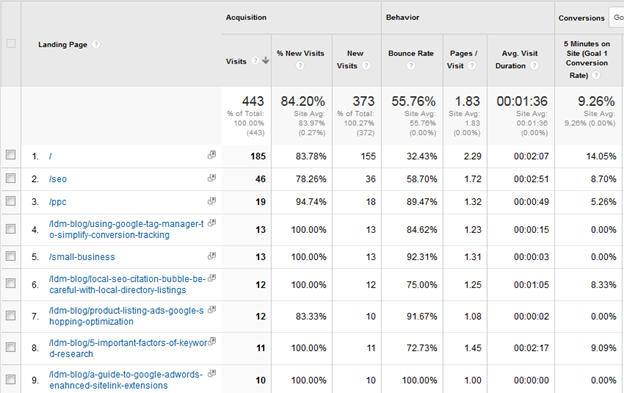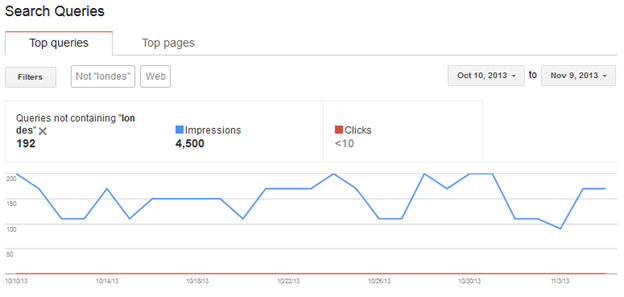- By: Mike LaLonde
- November 11, 2013
SEO Reporting as Google Turns to 100% Secure Search (Not Provided)
With Google making all their organic search referrals anonymous, there has been quite an uproar among the SEO community regarding what to do about it. Of course we’re not very happy about the move, but it’s been rather inevitable since the introduction of the concept a couple years ago. Here’s the official announcement on Google Blog saying that they’re moving to 100% secure search for users.
What this means for markers and website owners is that we’ll no longer know what search terms are driving traffic to your website. Since this is a large part of not only our reporting, but strategic process as well, we had to figure out what we’re going to do now.
Rand Fishkin over at the Moz blog covered a lot of this very well, so be sure to take a look at this video as well. My post here focuses more on the basic reporting aspects for clients and less on what we do behind the scenes to formulate our strategy.
Connecting Rank Improvement with Performance Growth
When we provide our monthly reporting, we like to show how much business we’re bringing our clients. That may be in terms of e-commerce sales, leads, engagement, traffic, or microconversions. In the past, we’ve filtered keywords and reported on KPI’s for groups of keyword targets.
We’ve never offered the “for $X you can pick Y keywords and we’ll try to rank them” package. It’s a bad model, and it’s not in the best interest of the website owner. I’ll save that rant for another day. What we’ve done instead is filtered keywords to summarize groupings of keyword targets (searches containing the term “SEO” or containing the term “marketing”, for example) and reported on that traffic and performance. We can’t do that anymore.
Primary Solution: Landing Page Organic Traffic Analysis
For most of our clients, we’ll be using organic search landing page analysis to report on successes. It’s not as granular and leaves us some guesswork from a strategic standpoint, but for reporting it should give you a snapshot of what products or services visitors are interested in on your website. What it does is reports the landing page users are visiting from search engines and the performance of those pages (the keywords we’re targeting typically rank for the most relevant page on your website).
By comparing rank improvements (which we can certainly still track), traffic to different landing pages, and tying in volume estimates, we can still provide a reasonable guide to where our SEO efforts are being successful.
Branded vs. Non-Branded Search Referrals
As an SEO company, our primary focus is increasing non-branded traffic. Branded traffic is more a measurement of your PR activities and brand awareness (which SEO’s I suppose do have some influence over, but it’s not the primary focus). We’re more interested in increasing traffic on searches looking for your services, not people looking for you.
We used to be able to filter out brand names to easily find out how many non-branded searches there were. With secure search, we’re no longer able to do that.
How to Estimate Branded vs. Non-Branded Searches…
Option 1: Google Webmaster Tools
This method should work fairly well for larger brands and websites. Google seems to need a certain amount of volume in order to be accurate. So if clients are running a small business or brand, it’s of minimal use, but otherwise we’ll estimate using Google Webmaster Tools filters.
Option 2: Google Adwords Traffic Estimator
I really don’t like this one very much. Traffic Estimator and Keyword Tool don’t seem to estimate things very well. Again, the larger the business or quantity of searches, the more likely this is to be accurate. The same logic goes for using Google Trends.
Option 3: Bid on Branded Adwords Keywords
Big surprise, there are advantages to paying Google. Most of their business decisions seem to be profit-focused these days. Anyways, if a paid search campaign is running which bids on branded terms via Adwords, there will be much more reliable impression and click data for the paid search terms.
Using that impression data and comparing it to historical click-thru numbers, we’re able to estimate branded organic traffic.
Assessing Keyword Value
All keywords are not created equal. With keyword-level referral data, we were able to monitor and report on usability and conversion performance for each keyword. Without that, we’re not able to tell which keywords are driving great numbers, and which ones have poor performance.
On a broader level, we can look at this data on a landing page level. If a certain category on your e-commerce site is getting a lot of organic traffic but has poor sales and engagement numbers, we can recommend reviewing those products or the layout to improve performance. But that’s for grouped keyword sets, not individual keywords.
Another option is using Google Keyword Planner’s approximate CPC’s to estimate the value of the keywords that we’re ranking well for and driving traffic on. Keyword Planner’s estimates give decent approximations (at least on a relative basis), and from there we can estimate value based on things like rank and total landing page visits relative to the number of keywords ranking on that page. So we’re talking an estimation of an estimation, which is less than ideal.
Another option is to actually run an Adwords campaign that includes the keywords you’re ranking for. We still get performance data on paid search terms, and it’s a pretty fair assumption that paid search visitors perform somewhat similarly to organic visitors on the same key terms. Using the performance data on paid search terms, you can use that knowledge to shape an organic search strategy and target keywords that perform well on your website.
New Reporting Outline
We’ll continue to do custom reports for clients based on KPI’s and the opportunities their website provides from a structural standpoint, but in general these are the changes we’re making:
Removed: Traffic filtered by branded, non-branded, and (not provided) terms.
Added: Google Webmaster Tools report on branded and non-branded terms.
Removed: Top Keywords and Top Landing Page Report.
Added: Complete Google Analytics landing page report with conversion/engagement metrics.
Removed: Filtered keyword referrals.
Added: Filtered landing page referrals.
* We’ll get a little creative with this based on your website structure. In some cases we can filter blog categories, service sections of the website, or different types of visitors that can be filtered based on some visitor dimensions (geographic location, mobile devices, etc).
Where We Go From Here
It’s always a challenge to provide useful, comprehensive reports quickly that are easily understandable for clients. After all, we’d rather spend client SEO budgets on actually performing SEO than doing reports.
The above solutions for the (not provided) problems should solve that problem, still providing useful performance information without needing to spend hours diving through data. Of course, for clients on larger budgets or those that can more directly benefit from more granular reporting (or “big data” as they like to call it), we’d be happy to discuss options as far as making changes or engaging in more advanced tactics to provide keyword-level data (my primary role these days is enterprise-level analytics, so I’d love to work with you on it).
For more details on our SEO reporting, take a look at our seo consulting page and navigate over to the “reporting” tab.

